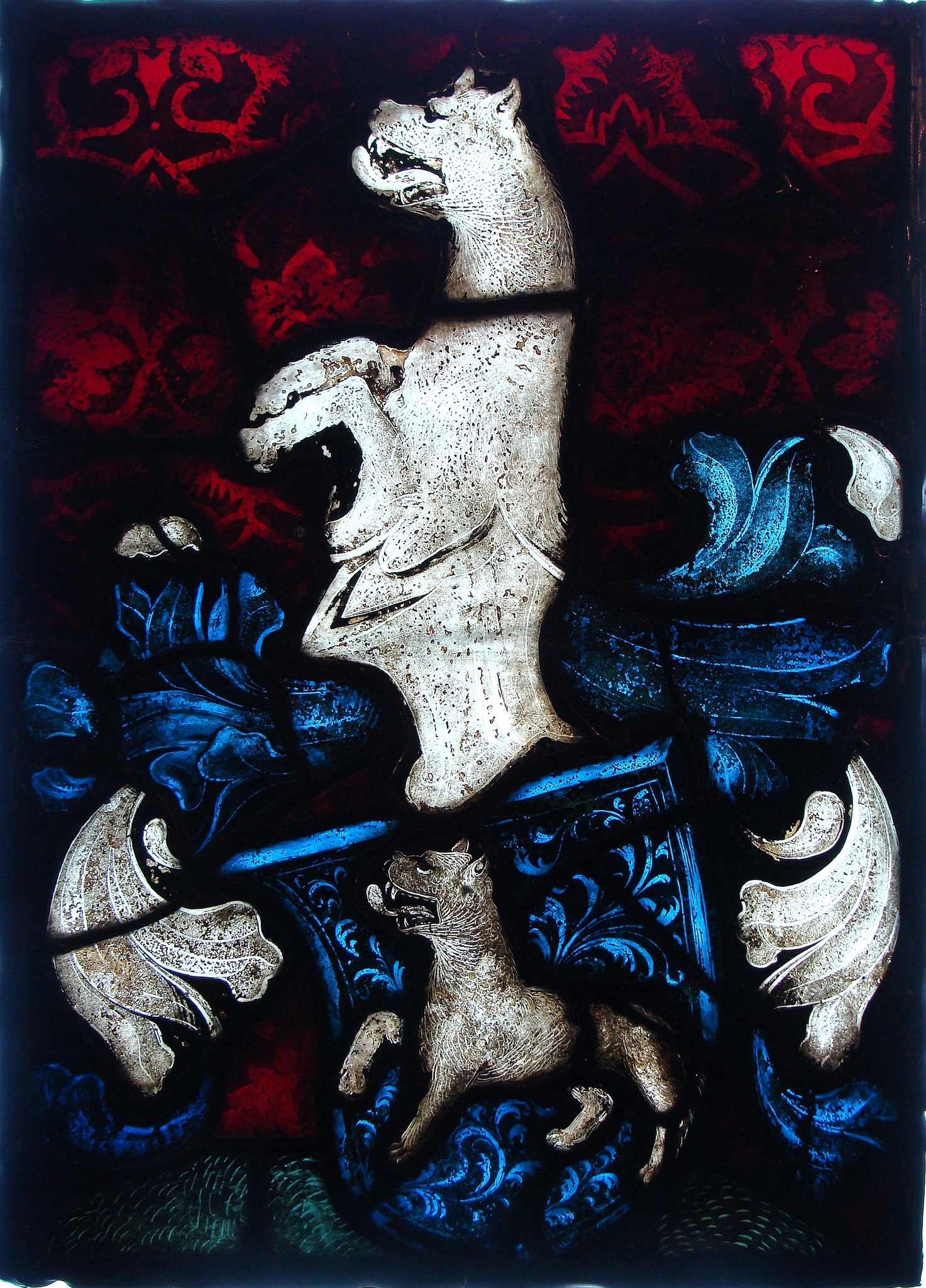The two coats of arms on damask ground face each other. They have both lost their original frames. The man's coat of arms belongs to the family of the Zigerli of Ringoltingen, that of the woman’s, to the Hunwil family. Rudolf von Ringoltigen, chief magistrate of the canton of Bern (1448, 1451, and 1454), and his second wife Paula von Hunwil are commemorated in the Three Kings window in the choir of the cathedral of Bern. The Los Angeles panels are closely related, but is not quite identical to this display. The shape of the shields suggests a slightly later date; they very probably belonged to the son of Rudolf, Thüring von Ringoltingen (c. 1415-after March 8, 1483), who also served as chief magistrate of Bern canton in 1458, 1461, 1464 and 1467, and his wife, Verena von Hunwil (c. 1428–before 1481). In 1456 he achieved lasting literary fame by translating the French romance, Melusine, compiled about 1382–1394 by Jean d’Arras, into German. Stone reliefs of the arms of Thüring von Ringoltingen and those of Verena Von Hunwil, dated 1458 from the church of Utzenstorf, are now in Schloss Landshut. Rudolf von Ringoltingen had acquired the castle and it remained in the family through the fifteenth century before being purchased by the city of Bern.
Hans Lehmann described the panels as “securely” by the hand of Hans Noll although he did not identify the owner of the shield (Lehmann, 1912, p. 294). Noll, one of the pioneers of Swiss glazing, was active in Bern from the 1470s until his death in 1493. His style was deeply indebted to the influence of Martin Schongauer. Probably the son of Peter Noll, a blacksmith, Noll served as a member of the Great Council in 1475. As a glass painter, he was active in Bern and Solothurn. He provided windows for the Premonstratensian Abbey of Gottstatt in the canton of Bern, and in the city of Bern he made windows for the Franciscan Abbey and cathedral. Brigitte Kurmann-Schwarz has documented his career and style (Kurmann-Schwarz, 1998, pp. 368–69, 407–414, 453–54, 470–71, esp. 495–97). She affirms the attribution of the Arms of the Association of Niedergerbern (a division of the city), dated 1471, to Noll, as he was the only securely documented glass painter in Bern in that year. Located in the cathedral’s Gerbern Association chapel (bay n XIII, 2b), the panel is part of the cathedral’s collection of single coats of arms. It shows precisely the same kind of foliate decorative work as that in the mantling surrounding the Los Angeles shields (Kurmann-Schwarz, 1998, fig. 310). The hound’s seemingly boneless structure is also analogous to the appearance of the rampant lions in the Niedergerbern shield. Several other panels in the cathedral show similarities, especially that of Claudius von Valangin executed shortly before 1491 (bay N V, 2c; Kurmann-Schwarz, 1998, pp. 407–415, Abb. 263). The mantling of the shields is similar, and the griffin heads in Bern are not unlike the hounds in the shield of Verena von Hunwil.
Christine Hediger suggests that the Los Angeles panels could have been in either the family chapel of the Ringoltingen in the cathedral of Bern or the church of Utzenstorf, where the family owned the ius patronatus (Hediger, 2012). Panels of similar formats were common in Switzerland, for example, the Arms of Dietrich I of Englisberg and Madeline of Praroman, about 1483–86, by an unidentified Fribourg glasspainter. The Fribourg panel shows the same damascene grounds and reciprocity between intense red and blue balanced by uncolored glass (Musée Ariana Geneva, CE 8612; GE_2109; Bergmann, 2014, fig. 123, p. 192).
Cited in:
Normile, 1946, pp. 43–44.
Hayward, 1989, p .67.
Hediger, 2012, pp. 333–43, fig. 409b.
Raguin, 2024, vol. 1, pp. 29–30, 105–109.
c. 1470
